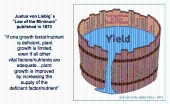In my research and wanderings, I've repeatedly heard of "solar saturation", the concept that in full sun, photosynthesis shuts down and plants stop growing. Solar saturation is presented as one of the reasons that forest gardening is so productive- multiple layers of vegetation shade each other so that no plants get solar-saturated and shut down, allowing for more complete photosynthesis. I've commonly heard that "a field of corn stops growing for four hours in the middle of the day due to solar saturation."
I have been searching for more information on the subject. I found mentions at
David Blume's site, and Mark Shepard's youtube presentations, but I looked on Wikipedia and Google and haven't found anything. What I have found, is "
the Saturation Point" which is the point at which light is no longer the limiting factor for photosynthesis, and ambient CO2 level becomes the limiting factor. This doesn't mean that photosynthesis "shuts down", though- just that it levels off.
Can anyone provide some thoughts or resources about this? I'm wondering if Solar Saturation is a misinterpretation of the Saturation Point, and has been repeated so often that it has become canon.










